Paris - The Usual Sights
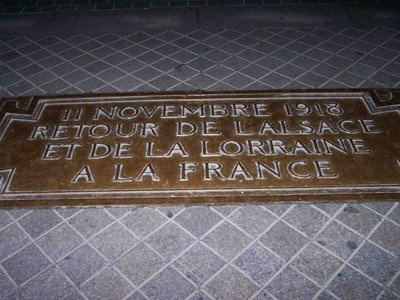
Paris is a pretty place when all decorated for Christmas. The weather was lousy, but I guess you have to expect that in December. But other than the bone-chilling-rain-driven-sideways-by-the-gale-force-winds, it was a great time to be a tourist.
Our first stop on this tour is the Arc de Triomphe. (Above, the Arc at night. In December, night comes at about 4:40 to Paris.) Napoleon gave the order for the arch to be built, back in 1806, to commemorate his conquests. Since then, the French Republic has continued to use the arch to commemorate significant military events. The most significant is the tomb of the unknown soldier, which is located near the center of the arch.
I was surprised to find that the monument contains two connections to Alsace. The first connection is one of the reliefs carved on the pillars...titled "La Marseillaise". La Marseillaise, currently the French national anthem, was written in Strasbourg in 1795 by Claude Joseph Rouget de Lisle. The people of Strasbourg take pride in this fact and seem to view the song as a gift given by Alsace to the rest of France. In fact, they take so much pride that they've named a couple of local bars after "La Marseillaise".
Digressing further....I can remember when there was a movement afoot in the USA to replace the Star Spangled Banner with America the Beautiful...on the premise that no nation should have a national anthem that speaks of war and battles. After learning the words to La Marseillaise, I laugh at this notion. After all, the chorus of La Marseillaise rings out with "...may impure blood soak our fields". Compared to that, the whole thought of "bombs bursting in air" seems pretty tame.
Digressing even further... La Marseillaise was adopted by the French not because they sang it in support of their government. It has never been an anthem of the government, but rather always an anthem of the people. And a rebellious people they can be. The song first became popular when a militia from Marseille marched to Paris to support the little uprising known as the French Revolution. Later, it became the anthem of the people as they rose up to depose Napoleon III to form the Second Republic. In the late 1800's the fledgling movement of international communism adopted la Marseillaise as their anthem...at least until they could write their own anthem, the "Internationale".
During the Second World War, la Marseillaise fit perfectly with the French Resistance ...where it was up to the citizens to arise and spill the impure blood of the invaders. The citizens still take pride in this song today. I will always remember the Soccer games this past summer for the World Cup. At the start of a match, when they played the national anthem on the television, you could hear the whole city of Strasbourg singing la Marseillaise. Everyone sang. And they sang loudly and with their hearts.
Ok....I said that the Arc de Triomphe had two connections to Alsace. Besides la Marseillaise, the second connection is the commemorative plaque shown in the intro picture. Very near the tomb of the unknown, in the pavement, there is this bronze marker that commemorates "November 11, 1918 - The return of Alsace and Lorraine to France". You see, the loss of Alsace and Lorraine to Germany in 1870 was a bitter pill for the French. Very bitter. They tell me that the geography texts used by French students from 1870 onwards would outline these lost territories in black as "French land under foreign occupation". To the generation...actually two or three generations...of Frenchmen born before WWI these lost territories were the promised land. And so, the recovery of Alsace and Lorraine at the conclusion of WWI was an especially proud moment for France. The plaque does not say "Nov 11 1918 - Armistice Day" or "Nov 11 1918 Victory in Europe Day". It marks the return of occupied territory. The generation that fought for these passions is long gone now, but this little bronze plaque serves as a reminder.
Wow, I'm really full of it today. Enough of the history and on with the tourist pictures.
Here is the Champs Élysées and a narrow view of the Christmas lights. Imagine these lights extending for a mile or so from the Arc de Triomphe down to the gates of the Louvre. I would give you a photo, but my camera is not so good and they all turned out blurry. The Eiffel Tower at night. For 10 minutes out of every hour the tower displays the blue flashing lights as a special treat. Of course, in this photo the blue lights don't flash. You will have to use your imagination.
The Eiffel Tower at night. For 10 minutes out of every hour the tower displays the blue flashing lights as a special treat. Of course, in this photo the blue lights don't flash. You will have to use your imagination. Here is the courtyard of the Louvre. If it looks grey and cold, that is because it was grey and cold.
Here is the courtyard of the Louvre. If it looks grey and cold, that is because it was grey and cold. Above is the Moulin Rouge. Though I gave some thought to going to a show, in the end I decided no. I did not want to spend the equivalent of 200 dollars to watch pretty naked women dancing. This is another sign of advancing age, I suppose. Also, it doesn't seem to be the ideal date to take the wife to.
Above is the Moulin Rouge. Though I gave some thought to going to a show, in the end I decided no. I did not want to spend the equivalent of 200 dollars to watch pretty naked women dancing. This is another sign of advancing age, I suppose. Also, it doesn't seem to be the ideal date to take the wife to. Above is the Basilica Sacré Coeur, or the basilica of the Sacred Heart. The basilica sits up at the top of Montmartre, at the highest point in Paris. Theoretically, you can take the funicular railway up to the top of the hill. Unfortunately though, it was out of service the day that we visited. In French, the term is "Hors service"... out of service. Not to complain, but it seemed that half of the machinery and/or rest rooms were "hors service" in Paris. C'est la vie.
Above is the Basilica Sacré Coeur, or the basilica of the Sacred Heart. The basilica sits up at the top of Montmartre, at the highest point in Paris. Theoretically, you can take the funicular railway up to the top of the hill. Unfortunately though, it was out of service the day that we visited. In French, the term is "Hors service"... out of service. Not to complain, but it seemed that half of the machinery and/or rest rooms were "hors service" in Paris. C'est la vie.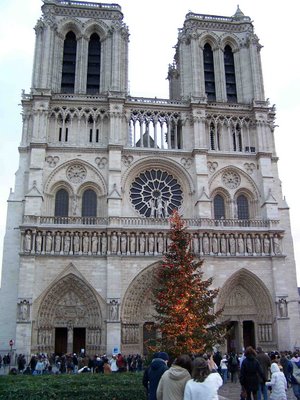 In closing, we leave you with the cathedral of Notre Dame. You will notice that the cathedral has no scaffolding around it. This is a rare thing in Europe. Also, you will note that the masonry is very white...which means that there must have been scaffolding recently to clean the place....but the job is finished and the scaffolding has since been removed
In closing, we leave you with the cathedral of Notre Dame. You will notice that the cathedral has no scaffolding around it. This is a rare thing in Europe. Also, you will note that the masonry is very white...which means that there must have been scaffolding recently to clean the place....but the job is finished and the scaffolding has since been removed
Also, please take note of the pretty little Christmas tree in front of the Cathedral. Inside and out the Cathedral was decorated for Christmas. At the time of our visit, they were celebrating a children's mass for the Feast of the Immaculate Conception. I find this to be very comforting. First of all, children are wonderful in any language and any culture. Secondly, when you are far away from home, it is nice to find things that accentuate the similarities and not the differences. Christmas is wonderful for that. It ties together Europe and America and much of the world in a common celebration. Whether you speak of Christmas or Noël or Weihnachten or la Navidad, it is all a common language.
And so it goes.
Thanks for suffering through one of the more rambling posts in the history of this blog. And Merry Christmas to you and all your loved ones.



 Theresa and I have acquired a bit of an addiction to raw oysters since coming to France. In fact, oysters have figured prominently in
Theresa and I have acquired a bit of an addiction to raw oysters since coming to France. In fact, oysters have figured prominently in  As another example of oyster-madness, we submit to you the following: Last Tuesday I stopped by the grocery and got two boxes of oysters....that's four dozen. They were size #2 and #3, which is the typical restaurant size. Theresa and I shucked and ate all four dozen for dinner. This is not something I would recommend for every night, but as an exception it is a special treat. Serve them with a nice dry white wine from Alsace and some brown bread and butter. Life does not get much better as far as food goes.
As another example of oyster-madness, we submit to you the following: Last Tuesday I stopped by the grocery and got two boxes of oysters....that's four dozen. They were size #2 and #3, which is the typical restaurant size. Theresa and I shucked and ate all four dozen for dinner. This is not something I would recommend for every night, but as an exception it is a special treat. Serve them with a nice dry white wine from Alsace and some brown bread and butter. Life does not get much better as far as food goes.
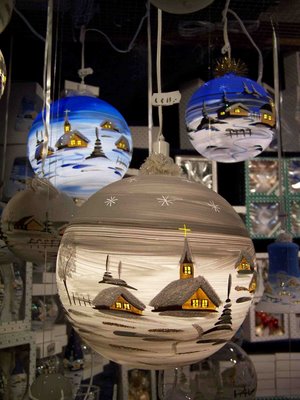
 There were also very tasty sausages to be had.
There were also very tasty sausages to be had. And the
And the 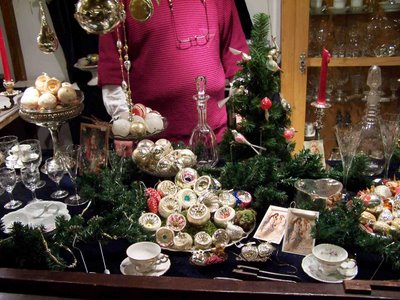 Some of the booths sell antique Christmas ornaments. These remind me of the ornaments that used to hang on the tree in my Grandmother Hertel's house.
Some of the booths sell antique Christmas ornaments. These remind me of the ornaments that used to hang on the tree in my Grandmother Hertel's house.


 Regardless, the trip to the top of the mountain was well worth it. Every visit has been different. This one was especially different because it is our last before we leave. I hope someday to visit again. I suspect that whether in 5 years or 10 or 20, the view will still be much the same. I suspect that Saint Odile herself would still recognize the view after 1300 years.
Regardless, the trip to the top of the mountain was well worth it. Every visit has been different. This one was especially different because it is our last before we leave. I hope someday to visit again. I suspect that whether in 5 years or 10 or 20, the view will still be much the same. I suspect that Saint Odile herself would still recognize the view after 1300 years.


 On Saturday, December 2, Theresa and Gabi and Cindy and I went to a small market in Rastatt and then the larger one in Baden Baden. Following are some pictures. Not a lot of comments here. I think you will get the feel of the little booths and the decorations and the Christmas atmosphere.
On Saturday, December 2, Theresa and Gabi and Cindy and I went to a small market in Rastatt and then the larger one in Baden Baden. Following are some pictures. Not a lot of comments here. I think you will get the feel of the little booths and the decorations and the Christmas atmosphere.
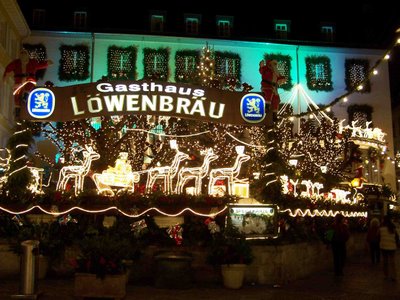
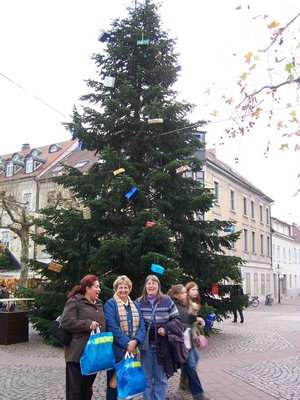

 You have to wonder how they did this. The architecture is an achievement but the engineering is a miracle. At the time the church was built, the ground surrounding Strasbourg was marsh and the water table on the island was much nearer to the surface than today. To lay the foundations, they first had to drive oak timber piling into the muck as supports. (Much like the way foundations were built in Venice) Then they piled stone after stone on top of that to build the platform. Then atop that they built the spire. All stones hoisted by ropes and pulleys and muscle.
You have to wonder how they did this. The architecture is an achievement but the engineering is a miracle. At the time the church was built, the ground surrounding Strasbourg was marsh and the water table on the island was much nearer to the surface than today. To lay the foundations, they first had to drive oak timber piling into the muck as supports. (Much like the way foundations were built in Venice) Then they piled stone after stone on top of that to build the platform. Then atop that they built the spire. All stones hoisted by ropes and pulleys and muscle.





 The chalet sits on the side of a mountain at about 1500 meters altitude. During the summer time, the mountain is segmented into pastures with barbed wire and electric fencing. The cows graze the mountain pastures during the summer. Then, in the fall, the farmers drive the cows down into the valleys. They also pull up all the fence posts and lay the barbed wire on the ground until spring. The mountain side then becomes a ski slope for the winter. A few tourists come, but not as many to Les Mosses as to the big ski resorts.
The chalet sits on the side of a mountain at about 1500 meters altitude. During the summer time, the mountain is segmented into pastures with barbed wire and electric fencing. The cows graze the mountain pastures during the summer. Then, in the fall, the farmers drive the cows down into the valleys. They also pull up all the fence posts and lay the barbed wire on the ground until spring. The mountain side then becomes a ski slope for the winter. A few tourists come, but not as many to Les Mosses as to the big ski resorts.
 The opening picture shows Chris and Jill and Tim silhouetted against he sky as they climb toward the peak of the mountain. The photo above shows them more closely, upon their return from the top. The rest of the photos just show some of the beautiful scenery that was to be seen on that day.
The opening picture shows Chris and Jill and Tim silhouetted against he sky as they climb toward the peak of the mountain. The photo above shows them more closely, upon their return from the top. The rest of the photos just show some of the beautiful scenery that was to be seen on that day.
 This last picture shows a stone wall that someone built on the side of the mountain at 2000 meters altitude or so. I walked up this stretch and my thighs burned and my lungs ached and my sense of balance strained to fight gravity and the uneven footing. I have the upmost respect for any farmer that could drag and then pile these stones to make a wall. Must have been one tough dude.
This last picture shows a stone wall that someone built on the side of the mountain at 2000 meters altitude or so. I walked up this stretch and my thighs burned and my lungs ached and my sense of balance strained to fight gravity and the uneven footing. I have the upmost respect for any farmer that could drag and then pile these stones to make a wall. Must have been one tough dude.
 Saturday was the day of turkey dinner. The intro picture shows Tim whipping up a pumpkin pie with the turkey just out of the oven in the foreground. Picture below has Joe preparing the potatos. Dinner was a team effort to prepare and a team effort to consume...as shown by the second picture below.
Saturday was the day of turkey dinner. The intro picture shows Tim whipping up a pumpkin pie with the turkey just out of the oven in the foreground. Picture below has Joe preparing the potatos. Dinner was a team effort to prepare and a team effort to consume...as shown by the second picture below.
 We had to drag food up that mountain for the other days as well. The picture below shows Friday night's two menu items - the
We had to drag food up that mountain for the other days as well. The picture below shows Friday night's two menu items - the 



